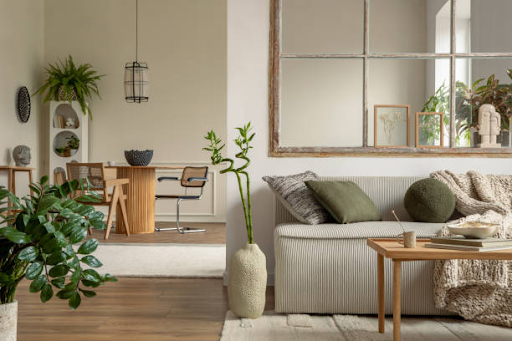In today’s rush of quick styles and factory-made goods, something calm is growing — something focused on realness, care for nature, and purpose. The idea didn’t start big; it was just slow fashion at first, but then it quietly spread into everyday life as a way called slow living. Like how slow fashion respects skilled work, fair materials, or thoughtful buying habits, those ideas now influence how people build their home spaces. Central to this shift? Choices shaped by care for Earth – handcrafted cushion covers, sheets carrying real GOTS labels, materials from nature, yet pieces assembled with thought – each mixing comfort with mindfulness in modern living spaces.
The Shift from Slow Fashion to Slow Living
The slow fashion movement began since fast fashion hurts Earth while mistreating laborers – still, it encouraged people to buy less, choose durable goods, yet support artisans who prioritize quality over fleeting trends.
Likewise, that mindset smoothly moved into home design, sparking interest in mindful living spaces — rooms thoughtfully gathered with intention, meaning, or realness.
Like clothes show who we are, so do the spaces where we live — they mirror how we choose to exist. Instead of chasing trends, people picking out furniture or building their dream home lean toward raw textures, old-school making methods, plus looks that don’t fade fast. These choices bring calm, depth, yet still feel lived-in. Take custom-stitched cushions or eco-approved bedding — small things actually standing for bigger ideas now; blending ease, care for earth, and richness without flash.
The Philosophy Behind Conscious Home Design
Conscious home design focuses on purpose. It pushes you to wonder not only what things look like, but their origin, production process, yet the people behind them. Each item in a slow living space holds meaning — maybe a handmade rug shaped by nearby crafters or eco-friendly pillows, verified safe, stitched from natural cotton raised minus toxic stuff.
This mindset encourages calmness while building awareness. Rather than cluttering spaces with throwaway items, thoughtful interiors lean into less stuff but higher quality — stuff that supports mental health yet treads lightly on the planet. It’s building your own escape spot – linked to nature, close connections, or quiet moments inside.
Craftsmanship as a Form of the Sustainability
Handmade pillows aren’t loved just in spite of their imperfections; actually, those quirks make them special, revealing truth and character with each uneven seam.
Every seam on a hand-sewn cushion shows care, while also being kinder to nature. Instead of factory-made goods, they’re usually built using nearby-sourced, planet-safe fabrics, put together in tiny runs — this cuts down trash and pollution. In the same way, GOTS-approved cushions follow tough ecological and fairness rules during making, so each stage — from growing cotton to final touches — sticks to worldwide green goals.
Natural Materials: Beauty Rooted in Nature
Natural stuff forms the base of slow fashion and a slower lifestyle. Instead of man-made textiles, people now use linen, organic cotton, hemp, or wool — each adding calm vibes through their feel and color at home. Take GOTS-approved cushions: they’re made completely from organic cotton while stuffed with earth-friendly, safe fibers. These don’t only feel good — they also ease your thoughts.
Designers now lean toward earth-friendly dyes, recycled timber, or fabrics that break down naturally — focusing on balance with nature.
Mindful Consumption:And Quality Over Quantity
Slow living says no to always buying more stuff. Rather, it pushes folks to pick things built to stay useful longer — objects with meaning, function, maybe even character. Going for handcrafted cushions shaped by experienced makers or bedding labeled GOTS, meeting tough eco-friendly rules, fits right into this thoughtful way of choosing.
Instead of changing decor every few months, slow living leans toward styles that last — calm colors, tough fabrics, maybe mix-and-match surfaces.Trading fads for consistency does good to the environment – and brings a calm vibe home, so unwinding feels natural while appreciating whatever’s nearby just clicks.
Bridging Fashion and Interior Design through Sustainability
One goes for truth when creating things; meanwhile, the other’s about living slower, more aware.
Your clothes from this mindset fit right into a home built on similar ideas — every item picked because it matters, lasts, or feels real. Each choice is shaped by awareness, not impulse.
A person who likes modern outfits from earth-friendly fabrics may lean toward GOTS-certified pillows – pure stuff combined with peaceful rest energy. Then again, someone drawn to handmade purses or necklaces will probably dig one-of-a-kind pillows that bring warm character into their space. Side by side, these choices prove eco-living goes beyond appearance – it’s about how decisions fit real routines.
The Emotional Connection to Handmade Home Décor
Besides looking nice or being eco-friendly, crafts made at home stir up real feelings. Leaning into a hand-stitched cushion means touching someone’s patience, work, and imagination. That kind of link brings appreciation and presence — basics behind taking life at a slower pace.
These bits make a home truly yours, where every piece holds some personal meaning. Not perfection or extra stuff defines beauty – rather, it comes from care and quiet focus.
Creating a Slow Living Home: A Modern Sanctuary
Setting up a relaxed-living house isn’t about big overhauls. It starts by paying attention — picking earth-friendly stuff, backing fair-trade makers, while appreciating skillful making. Adding handcrafted cushions or eco-approved bedding to your room is an easy but meaningful move that matches your surroundings with what you believe in.
Natural light, raw surfaces, or open layouts help build this aware setting. Each decision shapes a home that supports well-being, eases thoughts, yet honors nature.
Conclusion
The move toward thoughtful home decor reflects folks aiming to relax, simplify, or merely feel more connected. Just as sustainable fashion highlighted smarter closet decisions, embracing a quieter rhythm focuses awareness on how and where we use our hours. Choosing deliberately – be it handmade pillows or sheets produced ethically – builds rooms that seem genuine, gentle on Earth, or quietly peaceful. Choosing this rhythm doesn’t just change rooms; bit by bit, it reshapes how we move through each day.







